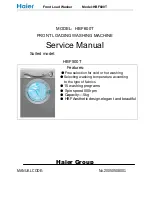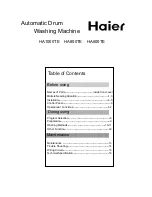
19
PART 3: OPERATION
In This Part—
• Theory of operation
• Description of operator controls
• Start up procedure
• Safety and operation checks
• Shutdown procedure
• Operation summary
3.1 Theory of Operation
Dishwashing requires five components to be effective: time, temperature, mechanical
action, chemical action and proper procedure. Time allows everything to work. Temperature
produced by the heat system is required to heat water in order to penetrate and loosen food soils.
Mechanical action produced by the pump system creates water pressure to flush food soils from
wares. Chemical action in the form of detergents break down grease and dissolve food particles.
Proper procedures in the form of prescrapping, prerinsing, and proper loading maximize
dishwasher performance.
The USN-72 series dishwasher consists of the wash tank and the power rinse tank. The power
rinse tank contains the final rinse piping. Each tank is equipped with its own spray system and a
water holding tank. Recirculating pumps draw water from the tanks and direct the water under
pressure through the spray system and onto the dishes.
Wash and power rinse water is heated in the tanks by a steam coil or electric tank heater.
The final rinse water for sanitizing is heated in an external steam or electric booster heater.
A rack conveyor system made up of dual chains and driven by a conveyor motor and gearbox
moves dishracks loaded with wares through the tanks. The wash tank water, which is heated to a
minimum of 150
°
F., contains detergents. Wares are conveyed to the wash tank where they are
sprayed with the detergent solution. Food particles and other soils are flushed from the wares and
are collected in scrap screens above the water holding tank. Wares continue on the conveyor
system to the power rinse tank which is heated to a minimum of 160
°
F. The power rinse tank
spray system rinses remaining soils and soapy water from the wares.
The final stage of the washing operation occurs in the final rinse section. Upper and lower final
rinse spray pipes are located at the exit end of the dishwasher. As the dishrack containing wares
approaches the final rinse area, the dishrack operates a final rinse switch. The switch activates
the final rinse system. Final rinse water, heated to a minimum of 180
°
F., is forced by water line
pressure from the final rinse booster heater. Water sprays from the upper and lower final rinse
piping on the wares to sanitize them. The wares are conveyed out the exit end of the dishwasher
where operators remove and stack the wares for the next meal period.
The USN-72 is equipped with several safety features. Door safety switches prevent the unit
from running if a door is open. A conveyor limit switch stops the dishwasher operation if the
conveyor becomes jammed. A float switch located in each tank stops the unit if the water level
falls below a preset level. Finally, a low temperature sensor stops machine operation if the final
rinse water falls below 180
°
F.
Part 3: OPERATION
Summary of Contents for 135-USN-72
Page 1: ......
Page 3: ...TECHNICAL PUBLICATION SHEET i TECHNICAL PUBLICATION SHEET ...
Page 4: ...TECHNICAL MANUAL VALIDATION CERTIFICATE ii TECHNICAL MANUAL VALIDATION CERTIFICATE ...
Page 5: ...APPROVAL AND PROCUREMENT RECORD iii APPROVAL AND PROCUREMENT RECORD ...
Page 9: ...vii THIS PAGE INTENTIONALLY LEFT BLANK ...
Page 36: ...THIS PAGE INTENTIONALLY LEFT BLANK 18 ...
Page 74: ...56 Part 6 REPLACEMENT PARTS THIS PAGE INTENTIONALLY LEFT BLANK ...
Page 83: ...65 Part 6 REPLACEMENT PARTS THIS PAGE INTENTIONALLY LEFT BLANK ...
Page 96: ...74 Part 6 REPLACEMENT PARTS Figure 6 8 Rinse saver assembly 1 2 3 4 9 10 11 2 2 12 5 4 6 7 8 ...
Page 98: ...76 Part 6 REPLACEMENT PARTS Figure 6 9 Steam coil assembly Tank 4 8 9 10 7 6 5 4 1 2 3 ...
Page 126: ...94 Part 6 REPLACEMENT PARTS Figure 6 18 Dishracks and PRV 1 2 3 ...
Page 130: ...98 Part 6 REPLACEMENT PARTS 1 2 3 4 5 6 7 8 9 Figure 6 20 MRAN 90 Pawl Bar ...
Page 142: ...110 Part 6 REPLACEMENT P ARTS THIS PAGE INTENTIONALLY LEFT BLANK ...
Page 143: ...111 Part 6 REPLACEMENT P ARTS PART 7 ELECTRICAL SCHEMATICS Part 7 ELECTRICAL SCHEMA TICS ...
Page 159: ...112 THIS PAGE INTENTIONALLY LEFT BLANK ...
Page 160: ...112 THIS PAGE INTENTIONALLY LEFT BLANK ...
Page 163: ...115 Part 6 REPLACEMENT P ARTS ...
















































